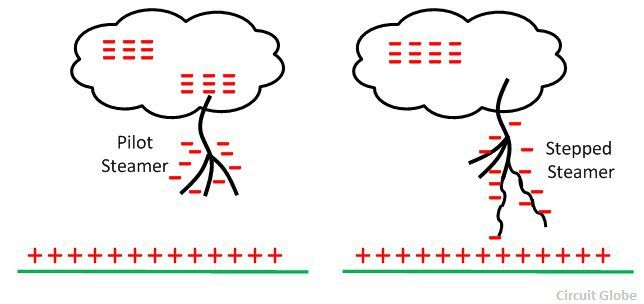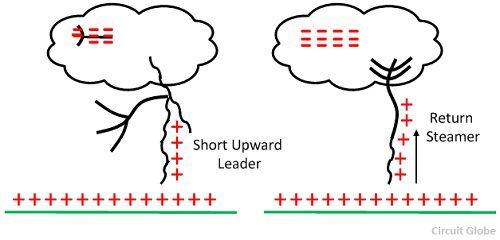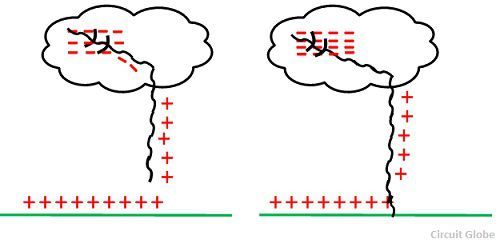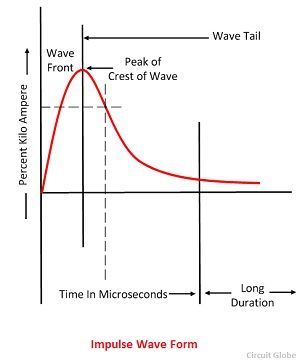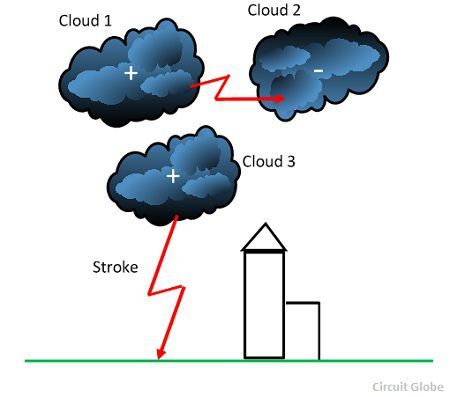Definition: Lightning stroke is the direct discharge of an electrical charge between the atmosphere and the object of earth. It is a sudden flow of electric charge between the electrical charge area of a cloud also called intra-cloud and another cloud called (CC lightning) or between the charged cloud and the ground (CG lightning).
The charge region of the cloud is equal to the electric discharge. When the cloud charge is discharged on the ground, then it is called a strike, and if the discharge is hit on the object, then it is called flash. The lightning occurs in the form of the plasma and sound in the form of thunder.
Mechanism of the Lightning Discharge
In the atmosphere, the positive, as well as the negative ions in the air, attach themselves to the small dust particles. The water drops present in the air also get charged because of polarisation by induction. These charged particles and water drops charged the clouds. The positive ions are collected in the upper region, and the negative ions are collected in the lower region of the cloud because of their mass.
When the charge cloud passes over the earth, it induces an opposite charge in the earth below. The potential difference in the cloud is not much greater than that at the earth’s surface, the discharge originates in the clouds. The potential gradient of the clouds is not uniform, and it is of the order of 10 – 30 KV/cm in any part of the cloud. The initial discharge which is also called pilot discharge or pilot leader moves slowly towards it from the earth.
The first discharge moves to earth in steps of about 50 meters each and is, therefore, termed the stepped leader. The pilot leader carries a charge with it, and the potential gradient at its tips is very high. It ionises the air and provides a path or channel for the pilot leader. The channel also becomes charged. The pilot leader carries secondary steamer which branches out from it.
When the pilot steamer reaches near the earth, the electric field intensity increases and due to this, the charges of an opposite polarity in the form of a short steam rises from the earth to meet the tip of downward leader. When a contact is made between the pilot leader and the short upward steamer, a return streamer travel from the earth to cloud along the ionised channel formed by the pilot leader. The return steamer moves very fast and produces the well known, intensely luminous lightning flash.
The potential of the portion of the cloud from where the discharge originated is lowered by the passage of the charge through the ionised channel to the earth. But the other portion of the clouds remains charged. Therefore, a high potential develops between the original charge centre and another charge centre in the clouds.
The charge of the other charge centre is first transferred to the first one, and then it passes to the earth through the ionised channel made by the first discharge. The second’s discharge is unbranched and without steps. Its velocity is more than that of the pilot leader. This is known as the dart leader, and it is also followed by the return strokes.
Similarly, the other charges are discharged to the earth in the form of leader and return strokes along the same ionised channel. Lightning strokes with any discharge are known as multiple or repetitive strokes. The lightning is called referred to as hot or cold depending upon the magnitude and duration of the stroke.
The stroke of lightning has a low current but long duration. It causes the fire when it strokes on the object. The stroke of cold, lightning has a high current, but it is of short duration. It causes an explosion when it strikes on an object.
Waves Shapes of Stroke Currents
The wave shapes consist of a portion showing the steep rise of voltage up to a peak or crest value called the wavefront, and the other portion showing the decay of voltage called the wave tail. Such a wave shape may be represented as the difference of two exponentials, thus
Where the ∝ and β show the constants which determine the shapes. The waves are defined by times t1 and t2 in milliseconds. The times to reach the impulse current or voltage to its maximum amplitude is denoted by t1, while t2 denotes the times when the current or voltages has fallen to one-half of its peak value.
Types of Lightning Stroke
The lightning stroke affects the lines in two ways
- Direct stroke
- Electrostatic induction.
These ways are explained below in details.
1. Direct Stroke
In the direct lightning strokes, the cloud attains a large amount of charge and induces an opposite charge on taller objects such as temple, churches or mosques. When the intensity of electrostatic field becomes sufficiently great to ionise the neighbouring air, the air break down and discharge takes place between the cloud and the object. Such types of discharge take a long time to produce, and it strikes the highest and the most sharply pointed building in the neighbourhood.
2. Electrostatic Induction Stroke
Consider the three clouds, clouds 1 and 3 are positively charged, and cloud 2 is negatively charged as shown in the figure below.
The potential of cloud 3 is reduced due to the presence of the charged cloud 2. On the flash over from Cloud 1 to Cloud 2, both these clouds are discharged rapidly, and class 3 assumes a much potential and flashes to earth very rapidly. It is the most dangerous strokes because it ignores taller building and reaches directly to the ground. This stroke is called the induces strokes.

